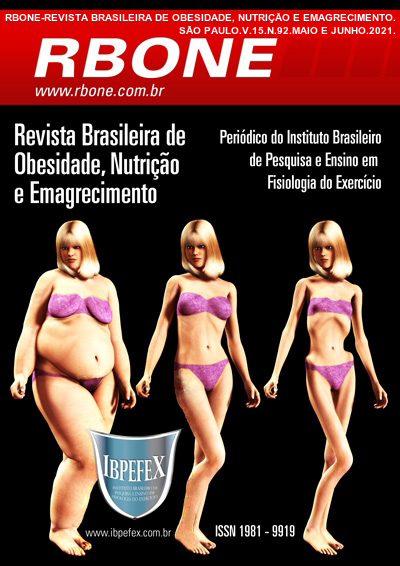Assessment of body image perception in adolescents
Abstract
Introduction: Adolescence is a period of several physical changes, which due to the influence of the media and idealized images of bodies can also be a period in which adolescents develop different eating disorders. Objective: To evaluate the perception of body image in adolescents. Material and methods: The sample consisted of 44 adolescents from the Cônego Paulo Monteiro State School in São João da Mata-MG. Height and weight were measured using a tape measure and mechanical scale. After obtaining the anthropometric data, BMI (Body Mass Index) was calculated. To analyze the body image of the adolescents, the Stunkard Scale was used. Results: Among the 44 adolescents surveyed, there was a prevalence of females, representing 59.09%, with an average age of 15 years. Most weighed around 60 kg and had an average height of 1.65 m. Only one of the adolescents participating in the survey declared smoking and 86.36% declared to practice physical activities. The body mass index (BMI) obtained from the measured height and weight of the participants was 22.09 kg / m2 on average. Regarding body image, the predominance of responses was related to the silhouettes of eutrophic individuals. Discussion: When correlating self-perception with nutritional status, there was no distortion of reality. Conclusion: From the data obtained with the current research, it can be concluded that most participating adolescents do not present body image distortion. The evaluated sample did not show any significant results indicating distortion in body image and dissatisfaction with it and, according to the initial hypotheses of the research, they were contradicted.
References
-Branco, L. M.; Hilário, M. O. E.; Cintra, I. P. Percepção e satisfação corporal em adolescentes e a relação com seu estado nutricional. Rev. Psiq. Clín. Vol. 33. Num. 6. 2006. p. 292-296.
-Brasil. Ministério da Saúde. Secretaria de Atenção em Saúde. Departamento de Ações Programáticas Estratégicas. Diretrizes nacionais para a atenção integral à saúde de adolescentes e jovens na promoção, proteção e recuperação da saúde. / Ministério da Saúde, Secretaria de Atenção em Saúde, Departamento de Ações Programáticas Estratégicas, Área Técnica de Saúde do Adolescente e do Jovem. Brasília: Ministério da Saúde. 2010.
-Brasil. OPAS. (Org.). Transtornos Alimentares: Transtornos Alimentares. 2019. Disponível em: . Acesso em: 23/04/2019.
-Fortes, L. S.; Miranda, V. P. N.; Ferreira, M. E. C. Insatisfação Corporal e Atividade Física em Adolescentes de Juiz de Fora-MG. Pensar a Prática. Vol. 16. Num. 2. 2013. p. 320- ¬618.
-Guerra, P. H.; Farias Junior, J. C.; Florindo, A. A. Comportamento sedentário em crianças e adolescentes brasileiros: revisão sistemática. Rev. Saúde Pública. Vol. 50. Num. 9. 2016.
-Lima, M. F. C.; Lopes, P. R. N. R.; Silva, R. G.; Faria, R. C.; Amorim, P. R. S. Marins, J.C. B. Questionários para avaliação do nível de atividade física habitual em adolescentes brasileiros: uma revisão sistemática. Revista Bras. Ciênc. Esporte. Vol. 41. Num. 3. 2019. p. 233-240.
-Lopes, A. C. S.; Caiaffa, W. T.; Sichieri, R.; Mingoti, S. A.; Lima-Costa, M. F. F. Estado nutricional: antropometria, consumo alimentar e dosagens bioquímicas de adultos e idosos - projeto Bambuí um estudo de base populacional. Revista Mineira de Enfermagem. Vol. 12. Num. 4. 2009.
-Mendes, N. V. F. Satisfação com a Imagem Corporal em Adolescentes do Ensino Secundário: relação com a prática de atividade física. Dissertação de Mestrado. Escola Superior de Educação e Ciências Sociais do Instituto Politécnico de Leiria. 2016.
-Moreno, L. A.; e colaboradores. Nutrition and Lifestyle in European Adolescents: The helena (Healthy Lifestyle in Europe by Nutrition in Adolescence) Study. Adv. Nutr. Vol. 5. Núm. 5. 2014. p. 615-623.
-Neves, A. N.; Hirata, K. M.; Tavares, M. C. G. C. F. Imagem corporal, trauma e resiliência: reflexões sobre o papel do professor de Educação Física. Revista Quadrimestral da Associação Brasileira de Psicologia Escolar e Educacional. Vol. 19. Num. 1. 2015. p. 97-104.
-Petroski, E. D.; e colaboradores. Motivos e prevalência de insatisfação com a imagem corporal em adolescentes. Ciênc. Saúde coletiva. Vol.17. Num. 4. 2012.
-Secchi, K.; Camargo, B. V.; Bertoldo, R. B. Percepção da Imagem Corporal e Representações Sociais do Corpo. Psicologia: Teoria e Pesquisa. Vol. 25. Num. 2. 2009. p. 229-236.
-Sousa, M. R. M.; Rodrigues, P. A. S.; Rodrigues, I. P.; Silva, A. C. F. Avaliação da percepção da imagem corporal em adolescentes de uma escola pública estadual no município de Fortaleza-Ceará. Revista Brasileira de Obesidade, Nutrição e Emagrecimento. São Paulo. Vol. 14. Num. 87. 2020. p. 571-577.
-Souza, R. P. Os benefícios da prática de atividade física e os riscos do sedentarismo em: crianças e adolescentes, no adulto e no idoso. Cinergis. Vol. 11. Num. 1. 2010. p.52-59.
-Vasconcelos-Raposo, J.; Teixeira, C. M.; Pinto, A. F.; Pereira, C. A.; Fernandes, M. G.; Pinto, M. Atividade física, satisfação com a imagem corporal e comportamentos alimentares em adolescentes. Revista Portuguesa de Ciência e Desporto. Porto. Vol. 14. Num. 3. 2014. p.15-32.
Copyright (c) 2022 Michelly Layana da Silva Prado, Ana Carolina Brasil e Bernardes

This work is licensed under a Creative Commons Attribution-NonCommercial 4.0 International License.
Authors who publish in this journal agree to the following terms:
- Authors retain the copyright and grant the journal the right of first publication, with work simultaneously licensed under the Creative Commons Attribution License BY-NC which allows the sharing of the work with acknowledgment of the authorship of the work and initial publication in this journal.
- Authors are authorized to enter into additional contracts separately for non-exclusive distribution of the version of the work published in this journal (eg, publishing in institutional repository or book chapter), with acknowledgment of authorship and initial publication in this journal.
- Authors are allowed and encouraged to post and distribute their work online (eg, in institutional repositories or on their personal page) at any point before or during the editorial process, as this can bring about productive change as well as increase impact and impact. citation of published work (See The Effect of Free Access).






